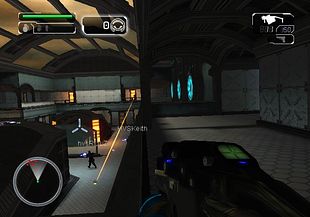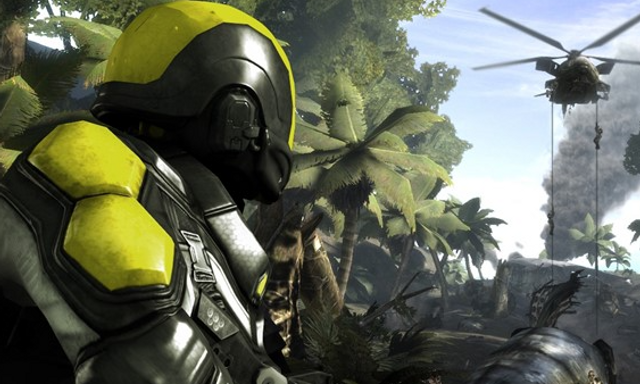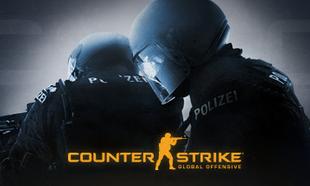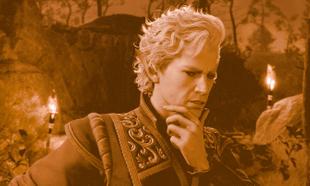Ever since 'Halo' burst onto the gaming scene in 2001, Microsoft has rightly touted their key franchise as the one to beat - leading to other developers trying to get in on the act.
Ahead of the release of 'Halo Infinite' we take a look at the times other developers tried to take on Microsoft's juggernaut - and mostly failed.
The most infamous example of a 'Halo killer', 'Haze' was Sony's attempt at cashing in on the euphoria and cultural moment created by 'Halo 3'.
'Timesplitters' developers Free Radical were tasked with creating a new blockbuster shooter for the PlayStation 3, which was in dire need of an exclusive hit by the time summer of 2008 rolled around.
'Haze' was published by Ubisoft so laying the blame at Sony's feet is not entirely accurate, however, Sony did convince Ubisoft to make the game a PlayStation 3 exclusive as the game as initially planned to be a multi-platform release.
Sony wanted a hit and something to compete with 'Halo' and their investment in 'Haze' seemed like a good idea at the time.
The idea for 'Haze' is incredible on paper; the game was to start out as your typical generic first-person shooter as the player go to war at the behest of a private military company, but halfway through the game, the player defects to the side of the rebels.
'Haze' had an open goal from 2 yards out to deconstruct the first-person shooter genre as we know it, and ended up being such a disaster it changed gaming history forever.
The plot had the potential for 'Starship Troopers' style commentary on the role war plays in contemporary society, and with the game coming out in 2008, there was a chance to make some social commentary about the wars in Iraq and Afghanistan.
'Haze' was to be the thinking mans 'Halo', now here's how they messed it up.
When the aforementioned switch happens halfway through, you would think the player would lose their regenerating health and powerful weapons, but in essence, all that really happens is the underpowered rebels can now fight as well as the private military company and the player is still a walking killing machine.
'Haze' is the most infamous example of a 'Halo' clone, because it ended up killing a beloved studio in the process.
Free Radical were in the early stages of development on a new 'Timesplitters' game but thanks to the studio's closure, that game never saw the light of day.
The domino effect caused by the failure of 'Haze' is truly astounding, and it all stems from Sony wanting a 'Halo' clone.
We were also treated to a Korn song written specifically for the game, so all in all, 'Haze' is a microcosm of the 2000's.
'Killzone' (2005-2013)
Sony's other attempt at a 'Halo killer' ended up as a modest hit.
The original 'Killzone' was released mere weeks before 'Halo 2' hit shelves, and the publicity and hype leading up to the game was something approaching fever pitch.
'Killzone' ended up selling well but nowhere near 'Halo' numbers, and only attained average-to-good reviews.
The 'Halo' games can be characterised by their large, sprawling environments and an epic, sweeping storyline with deep lore, and the original 'Killzone' came across as the supermarket great value version of 'Halo'.
'Killzone' looked impressive in 2004, but has aged horribly over 15 years later, no doubt owing to the industrial gun-metal grey colour scheme that dominates proceedings.
The 'Halo' games always had a bit of colour and life about them, whereas 'Killzone' had all the visual wonder of wandering around the paint aisle of B&Q.
'Halo' imagined a sci-fi universe with futuristic weapons and exciting new forms of transport, whereas 'Killzone' and its idea of the future was "what if it was World War 2, but in space?"
The original 'Killzone' was as dishwasher water dull as it sounds, but the cutscenes had a healthy dose of ham and cheese, with Brian Cox in particular taking chunks out of the digital scenery.
'Killzone 2' holds a dubious spot in gaming culture, with the 2005 E3 "gameplay demo" proving too good to be true.
The gameplay demo still looks impressive in 2021, but it may as well have been an episode of 'Paw Patrol' for how representative it was of the final game.
If you wonder why game developers are so keen to show off gameplay demos at E3, it's probably due to how 'Killzone 2' and its demo hoodwinked the industry at large.
As it turns out, the impressive trailer was all pre-rendered and was far beyond the capabilities of what the PlayStation 3 was capable of.
The finished product of 'Killzone 2' was nowhere near as impressive, but by early 2009, the PlayStation 3 wasn't really in that need of a blockbuster FPS anymore.
'Call Of Duty' was about to inherit the FPS throne, and Sony were already onto a winner with 'Uncharted 2: Drake's Fortune' as their blockbuster killer app.
The franchise has been on hiatus since 2013's 'Killzone: Shadow Fall' which sold decently as as a launch title for the PlayStation 4, but developers Guerilla Games moved onto bigger projects.
The 'Killzone' games were a crucial part of gaming history in the long-term.
The co-founder of 'Killzone' developers Guerilla Games, Hermen Hulst, is now the head of Sony Interactive Worldwide Studios, making him one of the gaming industry's most powerful figures.
The Dutch developers are hard at work on 'Horizon: Forbidden West', and series director Mathijs de Jonge's got his break in the industry with 2006 'Killzone' spin-off 'Killzone: Liberation for the PSP.
'Killzone' etched out a decent corner of the market for itself, but the games themselves aren't what put Sony back on top - it was the ingenious Dutchmen behind them.
An unintended side effect of Sony chasing their own version of 'Halo' ended up ushering in a bold, brave new era for Sony.
'The Conduit' - 2009
In defence of 'The Conduit', it had nothing to prove.
The Nintendo Wii was the biggest-selling console of its generation, but in 2009 Nintendo flirted with having more mature, action-orientated titles on its system.
The uber-violent 'House Of The Dead: Overkill' and 'MadWorld' sold as well as you'd expect as the consoles main demographic was mostly people playing 'Wii Fit' or 'Wii Bowling'.
Everyone and their mother had a Wii - why would Nintendo try to chase the 'Halo' demographic?
'The Conduit' was the answer to a question that never should have been asked in the first place, and owing to the Wii having the same graphical power as a calculator someone stood on, 'The Conduit' looked more like a child's drawing of the 'Halo' games than a triple AAA game.

'The Conduit' was a solid game where it mattered - the shooting of alien and human foes.
Add in a half-decent plot concerning an alien invasion of Washington DC and the bones of a good game are in there somewhere, but the technical limitations of the Wii quickly put paid to any further experiments with more mature-themed games on the Wii.
Of course, the Wii had such a lead over their rival consoles it didn't really matter how well 'The Conduit' sold, and indeed it's a testament to Nintendo that they were willing to chase the 'Halo' demographic by experimenting.
Adult content on a Nintendo system isn't necessarily that taboo a topic (the 'No More Heroes' and 'Bayonetta' games are a testament to that) but 'The Conduit' attempting to compete with the likes of 'Halo' or even 'Killzone' was misguided at best, delusional at worst.
2011's sequel 'Conduit 2' has an incredible cliffhanger ending that has sadly yet to be resolved.
Abraham Lincoln and George Washington step out of a portal in combat armour asking the player for help, setting up an epic sequel that never arrived.
Sure, 'Halo' is the game that brought multiplayer games to the masses and forever changed how games are perceived on an artistic and societal level but did it ever have two American presidents in power armour?
We think not.









































































